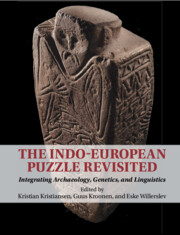Book contents
- The Indo-European Puzzle Revisited
- The Indo-European Puzzle Revisited
- Copyright page
- Contents
- Figures
- Tables
- Contributors
- Preface
- Introduction
- Part I Early Indo-European and the Origin of Pastoralism
- Part II Migratory Processes and Linguistic Dispersals between Yamnaya and the Corded Ware
- Part III The Cultural and Linguistic Significance of Bell Beakers along the Atlantic Fringe
- Part IV The Bronze Age Chariot and Wool Horizons
- Part V Kinship Systems, Marriage, Fosterage, Free, and Unfree
- 19 Mobility, Kinship, and Marriage in Indo-European Society
- 20 Marriage Strategies and Fosterage among the Indo-Europeans: A Linguistic Perspective
- 21 Fostering Women and Mobile Children in Final Neolithic and Early Bronze Age Central Europe
- 22 Hiding in Plain Sight? The Enigma of the Linguistic Remains of Prehistoric Slavery
- Concluding Reflections
- Index
- References
19 - Mobility, Kinship, and Marriage in Indo-European Society
from Part V - Kinship Systems, Marriage, Fosterage, Free, and Unfree
Published online by Cambridge University Press: 29 April 2023
- The Indo-European Puzzle Revisited
- The Indo-European Puzzle Revisited
- Copyright page
- Contents
- Figures
- Tables
- Contributors
- Preface
- Introduction
- Part I Early Indo-European and the Origin of Pastoralism
- Part II Migratory Processes and Linguistic Dispersals between Yamnaya and the Corded Ware
- Part III The Cultural and Linguistic Significance of Bell Beakers along the Atlantic Fringe
- Part IV The Bronze Age Chariot and Wool Horizons
- Part V Kinship Systems, Marriage, Fosterage, Free, and Unfree
- 19 Mobility, Kinship, and Marriage in Indo-European Society
- 20 Marriage Strategies and Fosterage among the Indo-Europeans: A Linguistic Perspective
- 21 Fostering Women and Mobile Children in Final Neolithic and Early Bronze Age Central Europe
- 22 Hiding in Plain Sight? The Enigma of the Linguistic Remains of Prehistoric Slavery
- Concluding Reflections
- Index
- References
Summary
The purpose of this chapter is to explore one area in which comparative linguistic data can play a role in interpreting late Neolithic and early Bronze Age genetic and archaeological data from western Eurasia. The sharp rise in available samples of ancient DNA enables the establishment of kinship relations between individuals in prehistoric graveyards. It also makes it possible to establish where their ancestors came from. The analysis of strontium, oxygen, carbon, and lead isotopes in the tooth enamel of these same individuals provides information about movements during their lives. When these techniques are combined, we obtain a much better idea about who moved where and when in prehistory. Being able to establish the diet of prehistoric individuals and which diseases they may have suffered from allows archaeologists to set up hypotheses as to why some of the population movements that can be observed in the archaeological data might have taken place. Linguistics can offer a valuable contribution to the discussion of why people moved by shedding light on factors other than diet or disease; it may, for example, help to explain cases in which males appear to have migrated differently from females. In order to understand how, this chapter will take a closer look at the linguistic evidence for kinship relations and the role of gender and age in Indo-European society. At the end of the chapter, hypotheses about mobility, kinship, and marriage in early Indo-European society as based on the linguistic data will be compared to the findings of recent research into ancient DNA and isotope analysis.
- Type
- Chapter
- Information
- The Indo-European Puzzle RevisitedIntegrating Archaeology, Genetics, and Linguistics, pp. 289 - 295Publisher: Cambridge University PressPrint publication year: 2023
References
- 1
- Cited by



